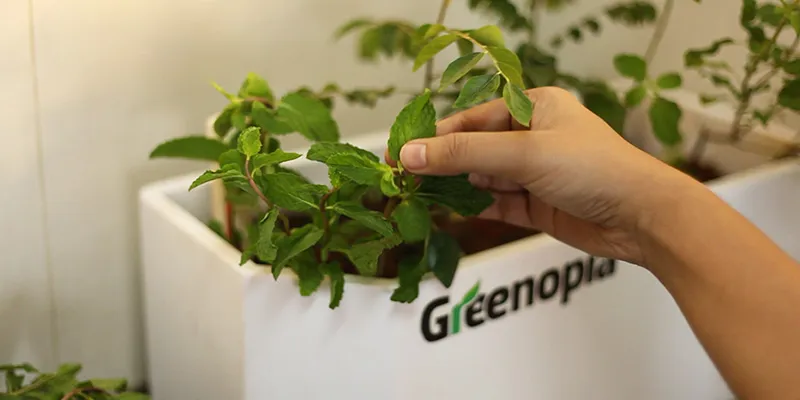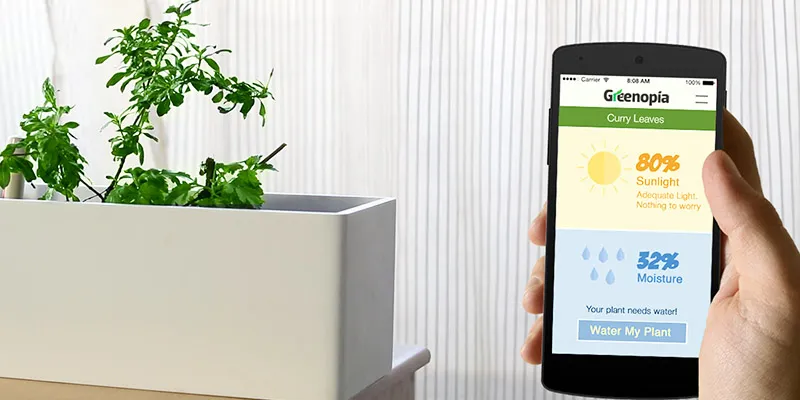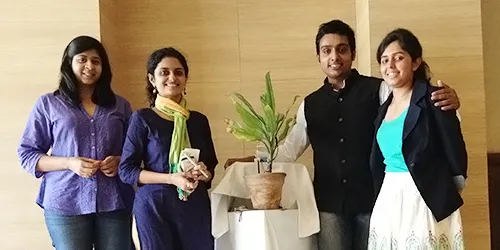Smart gardens: Greenopia makes gardening a ‘remote’ affair

Gardening is a hobby for many, but many beginners do not have the know-how to take optimum care of their home gardens and plants. Also, it’s difficult for people to monitor and take care of their gardens when they’re away from home. They generally rely on neighbours or friends to care for their plants.
With the Internet of Things revolution around the corner, a group of NID, NIT and IIM alumni are aiming to make home gardens ‘smarter’ with their product ‘Greenopia.’
What is it?
Greenopia is a smart gardening kit that consists of one or multiple smart pots and a mobile application that helps a user monitor and take care of their plants remotely. The smart pot has sensors that detect the status of a plant, like whether it’s receiving enough water and sunlight, or if soil conditions are optimum. The app acts as a personal gardening assistant and suggests what the user could do to maintain a healthy plant.
Greenopia is also trying to build a community or platform to help users share their pictures and experiences with other users on the platform.
Special features

Water your plants remotely: The smart pot has a motor and a reservoir to fill with water. When a user presses the 'water' button on his app, it sends a signal to the smart pot, which activates a motor that waters the plant.
Interactive community and crowdsourced data: Every time users grow a plant in a smart pot, they create data, which the community can benefit from. If someone grows the perfect parsley in Bangalore or Mumbai, the platform will save the data and the conditions that lead to it. It gives users smarter suggestions to grow parsley. Greenopia aims to create a crowdsourced, contextual, real-time library of plant data for the entire community to benefit and learn from.
Who is it for?
Greenopia is targeted towards urban professionals in the age group of 20 to 50 who have an interest in home gardening and live in temperate climates. The platform and product is targeted at both novices and experts, who have a lot of experience in gardening. For beginners, it helps monitor the vitals of their plants and water them remotely. It helps them understand the nuances of looking after plants.
Experts can contribute and give back to the community by providing their advice and know- how to beginners.
Team behind it

The team consists of technologists, entrepreneurs, gardening experts, researchers, product designers, user experience designers and managers from NID, NIT and IIM-Ahmedabad. The founding team consists of Mayukhini Pande, who heads Research at Greenopia , Devyani Jain, who is the UX design lead, Mani HK, who functions as the CEO and Veethika Mishra, the visual designer. Sudhakhar Damodaran, headed innovation in the Infosys Design Unit and is now a full time farmer and their Chief farming expert.Greenopia’s team consists of technologists, entrepreneurs, gardening experts, researchers, product designers, user experience designers and managers from NID, NIT and IIM-Ahmedabad.
Some of them came from small towns where they used to have kitchen gardens at home, and grew up on fresh and healthy food. They realised this experience was difficult to replicate in cities. They initially failed when they tried growing food themselves. They found that information available online was not always relevant to Indian plant species and the local climate. Also, finding experts to help in case of unique and difficult scenarios was not possible.
Design thinking process
The team claims Greenopia was born of design thinking. They started with the broader question on how they could make the quality of life better in cities and narrowed it down to: how to get people to grow their own food and eat healthier? They adopted four design thinking sensibilities for this venture:
User Centricity - Their designers began with understanding their users. They had deep conversations with their potential users to understand them as ‘whole' people, and not just fragmented statistics. They focussed on questions like what their users lives were like; what their desires and constraints were; what they thought about food; and how they saw the activity of growing plants. The team spoke to both novices and experts to get a rounded perspective.
Generating multiple alternatives: Having understood the situation, they generated multiple solutions, each with its pros and cons. After weighing each possibility, they finally froze on the current form.
Quick, iterative prototyping: Once they had multiple ideas, they made quick and dirty prototypes -from quick sketches to embedding their neighbour’s pots with sensors- and opened them up to multiple people for feedback. Prototyping then became their tool for validation, rather than just hypothetically arguing ideas out.
Thinking Systems: The team thinks of products as being part of a larger ecosystem. So to them, designing Greenopia meant not just designing the product, but also the interactions between users, smart pots, data, communities and services within the larger eco-system of food production and distribution. This is a complex activity, and also where their focus will increase in the future.
Challenges faced and future plans
Over the past year, they made three working prototypes and tested each. They focussed on both the design and the electronics that went into the product. They now have the validation that their product works well. As they were designers, the focus was not just on building a functional product, but something that was also sleek and beautiful.
Greenopia won the prestigious Indo-Russian MTS Innovatsii 2015 award, where it was acclaimed and validated by industry experts. The team’s focus now is to raise sufficient funds through crowdfunding for their product, go into production and ship their product to their backers.
Crowdfunding campaign: Greenopia







